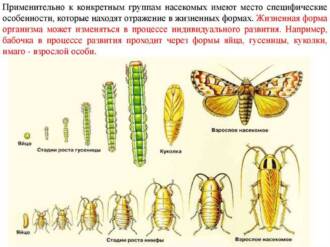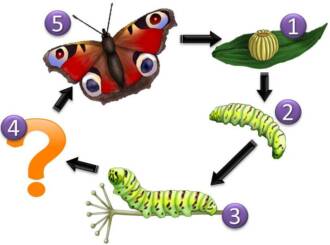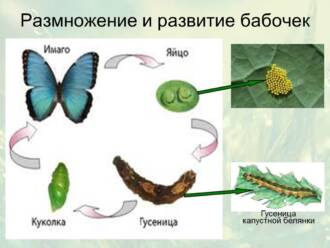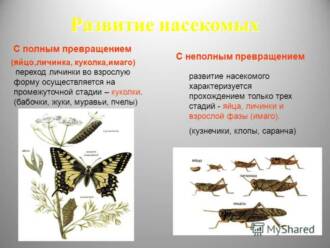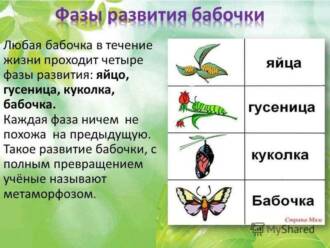
Butterflies are characterized by development passing through several stages. The first stage is the egg, which the female lays on the plant. The egg usually has various shapes and colors, which are determined by the type of butterfly.
After hatching, a caterpillar emerges from the egg. The caterpillar is the most active stage of butterfly development. She constantly feeds on the leaves of plants in order to gain enough nutrients for her growth and development.
The next stage is the pupa. The caterpillar enters this stage by forming a protective cocoon or hanging on a branch. Deep transformations occur inside the pupa: the caterpillar turns into an imago - an adult butterfly.
And finally, the last stage is the imago. The butterfly flies out of the chrysalis and begins an active life. Imagoes are distinguished by beautiful wings, which often have bright colors and patterns that help them attract the attention of males and females.
The main stages of the development of butterflies

Butterflies are characterized by development that goes through several stages: egg, caterpillar, pupa and imago.
The first stage is the egg. Butterflies lay eggs on plants that are food for future caterpillars. Eggs can be of different shapes and sizes, depending on the type of butterfly.
The second stage is the caterpillar. The egg hatches into a caterpillar that actively feeds and grows. Caterpillars usually have a soft body and many legs that help them move around plants.
The third stage is the pupa. After reaching a certain stage of development, the caterpillar turns into a pupa. The pupa usually has a hard shell, behind which internal transformations occur, allowing the caterpillar to turn into an adult butterfly.
The fourth and final stage is the imago. The chrysalis hatches into an adult butterfly, which can finally fly and reproduce. The imago has wings that allow it to maneuver in the air and find a partner for reproduction.
Egg: the beginning of the life cycle
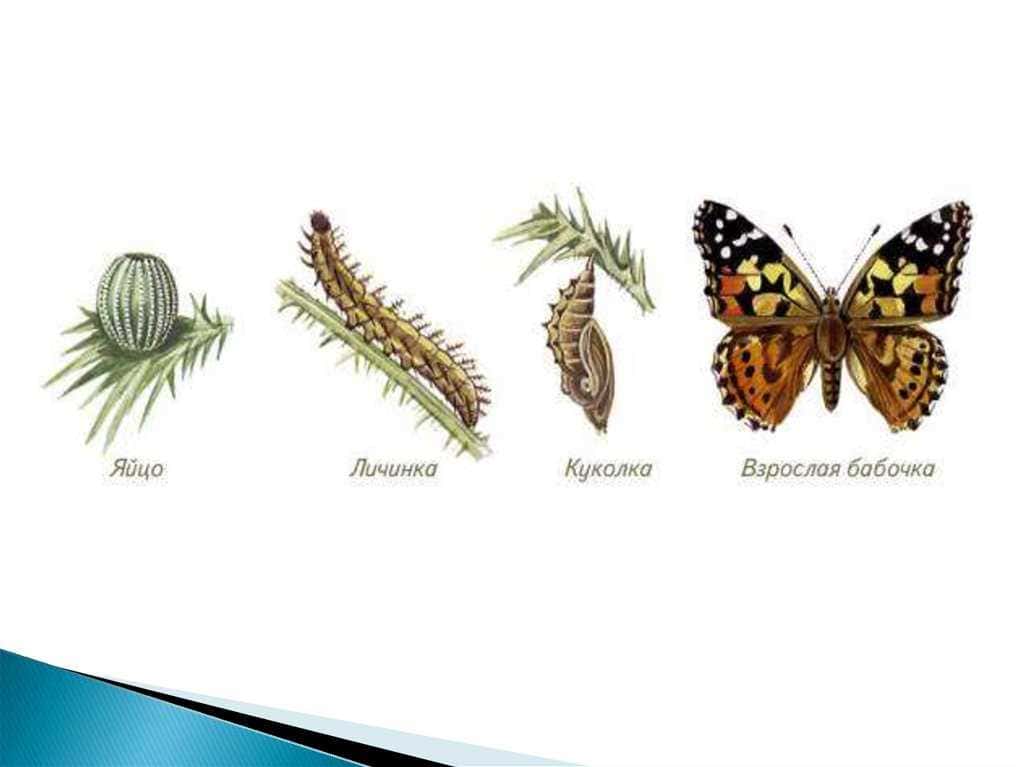
Butterflies are characterized by development that begins with an egg. Butterfly eggs are small oval or spherical structures that are laid by the female on various plants or other suitable surfaces. Most often, eggs are located on the leaves of plants so that in the future the larvae can feed and develop on them.
Butterfly eggs come in a variety of sizes, shapes, and colors. For example, some butterfly eggs may be flat and transparent, while others may be round and brightly colored. The color of the eggs often serves a camouflage function, helping them blend into their surroundings and avoid predators.
After laying eggs, the female leaves them to fend for themselves. They remain unprotected without direct maternal care. However, butterfly eggs do have a protective shell that helps keep them safe and protects them from outside influences. Inside the egg is the embryo, which begins to develop, feeding on the nutrient reserves accumulated in the egg.
The incubation period of eggs may vary depending on the species of butterfly and the environmental conditions. It usually lasts several days or weeks. After this time, the egg hatches into a larva, ready to begin its journey to becoming a full-fledged adult butterfly.
Caterpillar: active growth and nutrition
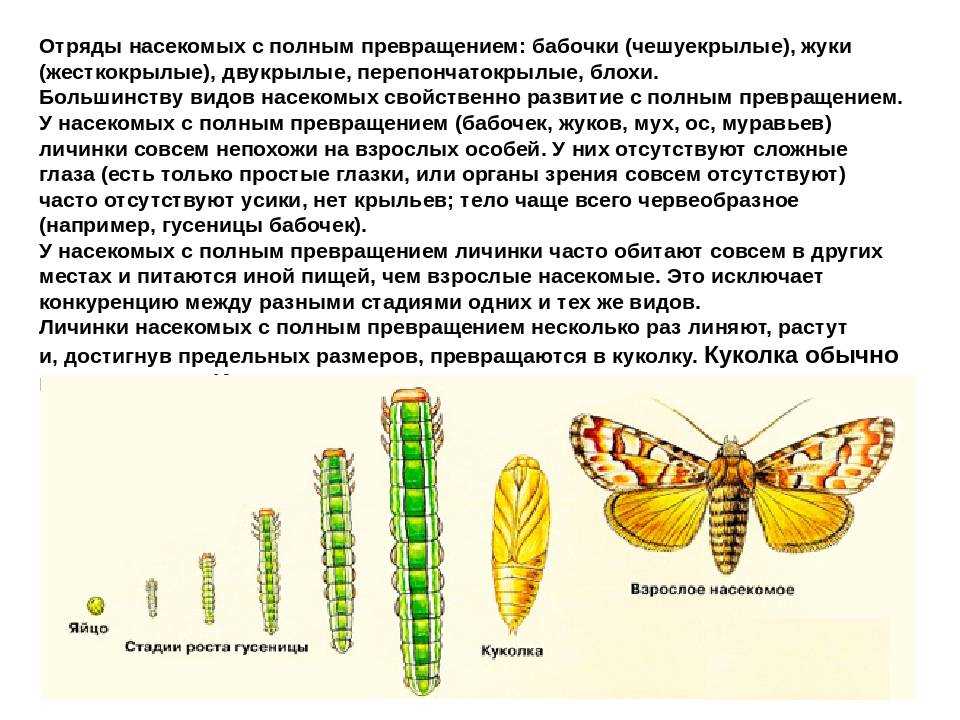
Butterflies typically develop through several stages, starting with the egg and ending with the imago. One of the main stages in this process is the caterpillar stage. The caterpillar is the active development of the butterfly when it is in the form of a larva.
During this stage, the caterpillar goes through active growth and feeding in order to get enough nutrients for its future development. Caterpillars have a large appetite and constantly eat leaves, flowers, and other plant materials in their environment.
Caterpillars have special digestive organs that allow them to efficiently process food and obtain the necessary nutrients. They also have powerful jaws that help them loosen and swallow their food.
It is important to note that caterpillars can be of different sizes and colors, depending on the type of butterfly. Some caterpillars may be green to better blend in with their surroundings, while others may be bright and colorful to deter predators.
Pupa: transitional stage

A pupa is one of the types of butterfly insect development. After the caterpillar hatches from the egg, it begins to actively feed and grow. When a caterpillar reaches a certain size, it goes through a molting process in which it sheds its old skin and grows a new one.
After several molts, the caterpillar reaches the last stage of its development and prepares to turn into a chrysalis. The caterpillar begins to look for a secluded place where it will be safe from predators and weather conditions. Then she turns into a chrysalis, forming a protective sheath around herself, which is called a cocoon.
A pupa is a transitional stage in the development of a butterfly, during which internal changes occur in the body of an insect. Inside the pupa, the tissues and organs of the caterpillar undergo transformation, and it turns into an adult butterfly. This process can take from several weeks to several months, depending on the type of butterfly and environmental conditions.
When the transformation inside the chrysalis is complete, the butterfly is ready to emerge into the light. She breaks her cocoon and flies out in the form of an imago - a fully formed adult insect. Imago is the last stage in the development of a butterfly, at which it can reproduce and continue its life cycle.
Larva: transformation into an adult animal

Butterflies typically develop through several stages. One of these stages is the larval stage. The larva is the second stage of butterfly development, following the egg.
At the beginning of its existence, the larva hatches from the egg and is small in size. She is a soft and vulnerable creature that needs nutrients for her growth and development.
During this stage, the larva actively eats plant food. It has a strong jaw that helps it crush and chew food. During this period, the larva periodically moves from one plant to another in search of a sufficient amount of food.
The larva continually grows and sheds its skin to increase its size. This process is called molting. After several molts, the larva reaches its maximum size and prepares for the next stage of development, the pupa stage.
Pupa: development inside the protective shell
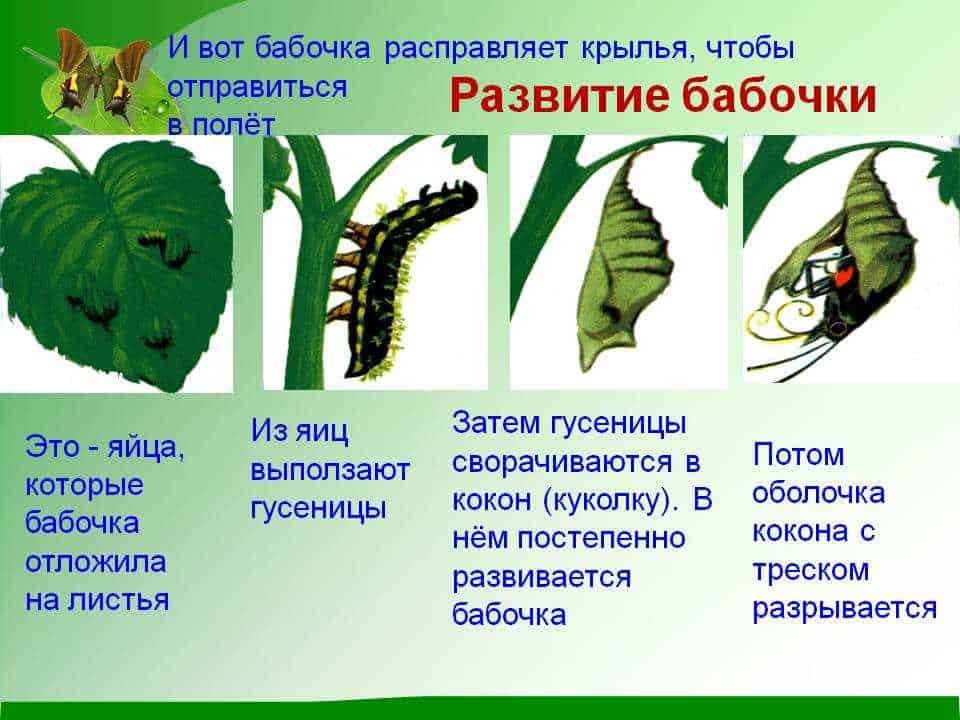
Butterflies are characterized by development inside a protective shell, which is called a chrysalis. When a butterfly reaches the larval stage, it begins the process of turning into a chrysalis.
The pupa is a special stage of development during which internal transformations take place. Inside the shell, the transformation of the larva into an adult butterfly occurs. During this period, the butterfly does not eat or move, it is completely focused on the transformation process.
Complex changes take place inside the pupa: old tissues are decomposed and new ones are formed, wings, antennae, legs and other organs are formed. All these changes take place under the protection of the puppet shell.
The pupa lasts a certain time, which may vary depending on the type of butterfly. Upon completion of development inside the shell, the butterfly is ready to emerge into the light. She breaks through the shell and flies out as an adult butterfly, ready for a new stage in her life.
Nymph: preparing to emerge from the chrysalis

Butterflies are characterized by development through several stages, including the pupal stage. When a butterfly reaches this stage, it is inside its chrysalis and preparing to emerge into the light. During this period, important processes take place that prepare the butterfly for its future flight and life.
Inside the pupa, the nymph goes through a series of physiological changes. It is actively developing, forming wings, legs and other parts of its body. Butterfly wings are formed gradually, the complex and beautiful pattern on them appears due to the unique process of cell development.
At this time, the butterfly's body is also undergoing a transformation process. It becomes more compact and flexible, and the muscles develop for future flight. The nymph spends a lot of energy on this process, and her body accumulates reserves of nutrients that will be needed for the first days after leaving the chrysalis.
The preparation of the nymph to emerge from the chrysalis is an important stage in the life of a butterfly. At this moment, she is in standby mode, but is already fully prepared for a new stage of her development. After emerging from the chrysalis, the butterfly will be ready to spread its wings and soar into the sky, beginning its adult life.
Imago: fully developed adult animal
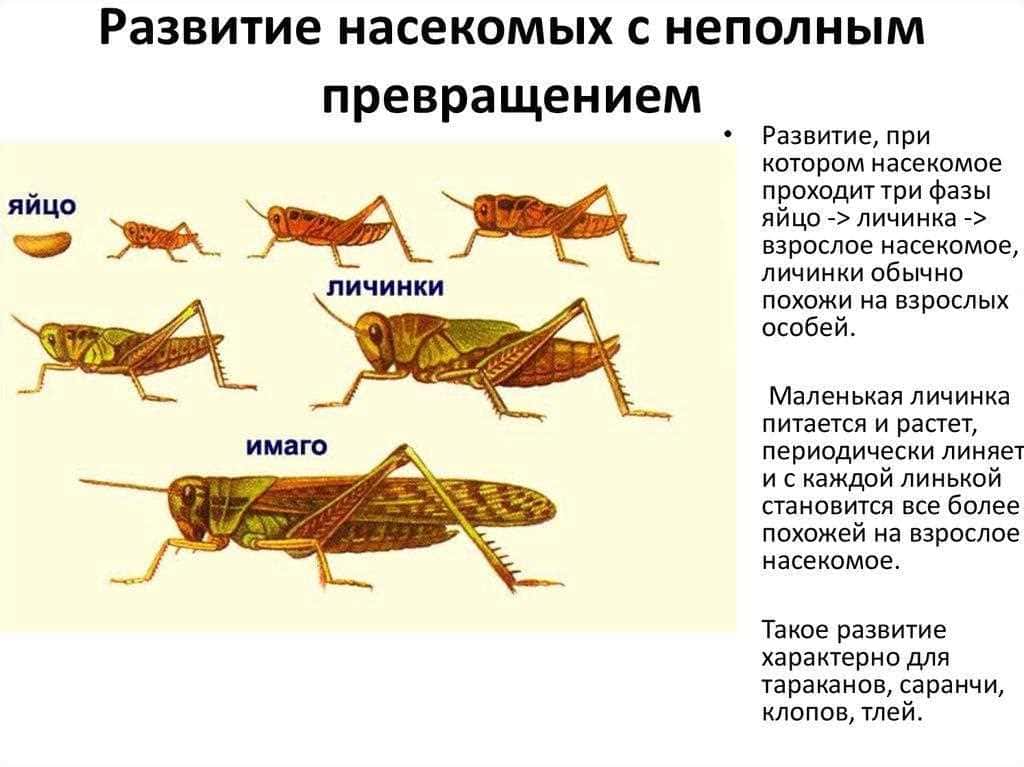
Imago is the last stage of the typical development of a butterfly insect. At this stage, the larva, having turned into a chrysalis, undergoes metamorphosis and turns into a fully formed adult animal.
After emerging from the chrysalis, the butterfly has wings that unfold and become fully functional. The wings are covered with scales, which give them beautiful and varied colors. The imago of the butterfly has two pairs of wings, which serve for flight and facilitate the search for food and reproduction.
An adult animal has distinctive features of its species, such as wing shape, coloration, body size and shape. These signs help determine the type of butterfly and distinguish it from other representatives. In addition, the imago has a developed system of sensory organs, such as antennae and eyes, which help it navigate the environment and find food.
Reproduction and continuation of the life cycle
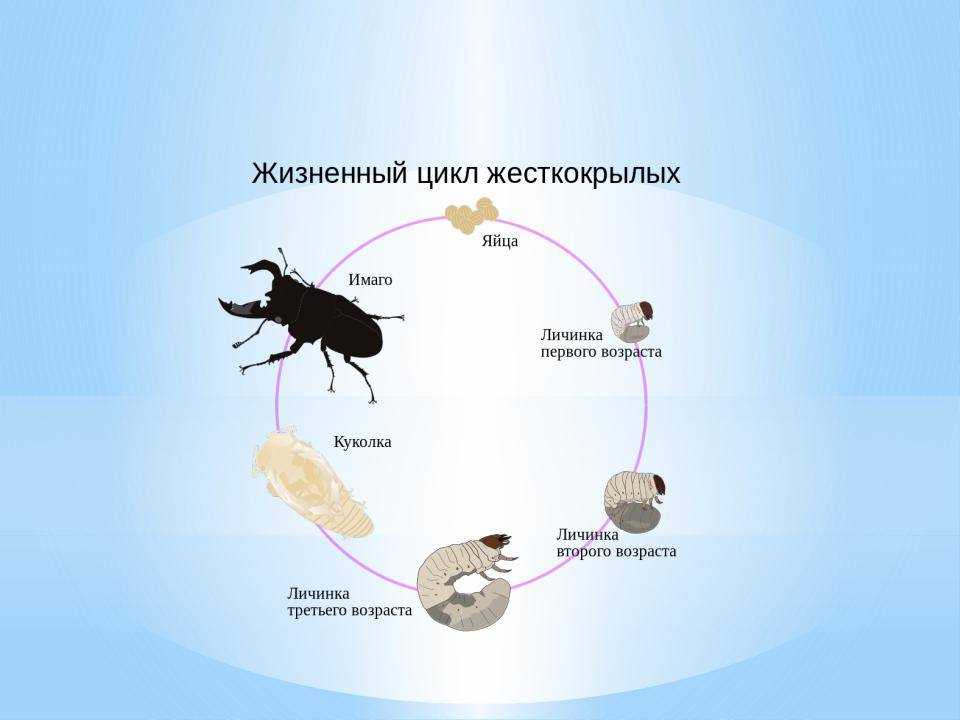
Butterflies typically develop through complete metamorphosis, meaning that they go through several stages of development, starting from an egg and ending with an adult species, the imago.
After fertilization, the female lays her eggs on suitable food vegetation. When the eggs hatch, hungry caterpillars emerge and actively feed to gain strength for the next stage of development.
Interestingly, caterpillars can go through several molts during which they grow and change their appearance. After each molt, they become more and more like an adult butterfly.
After the last molt, the caterpillar turns into a chrysalis, where the internal transformation of the body and the formation of the organs of the future butterfly takes place. After a certain time, the chrysalis splits, and an adult butterfly flies out of it - an imago.

